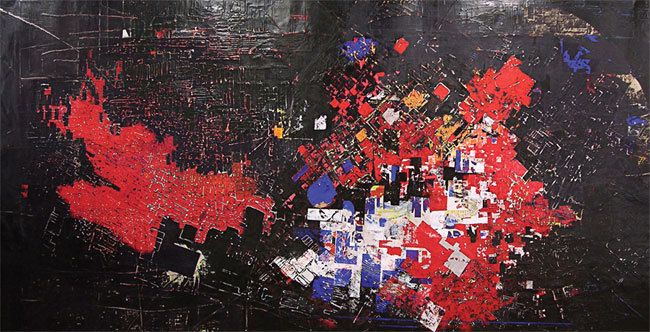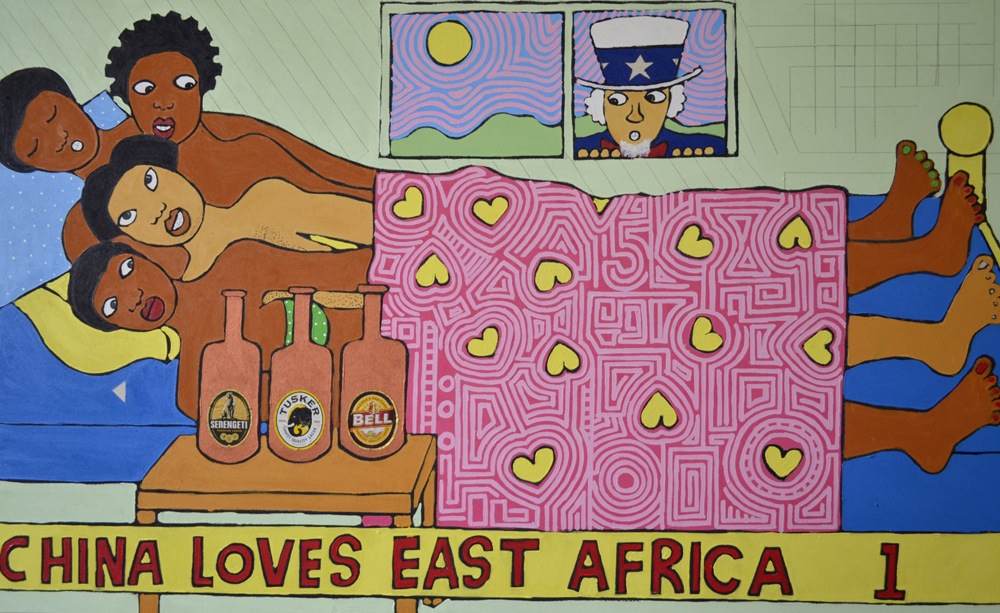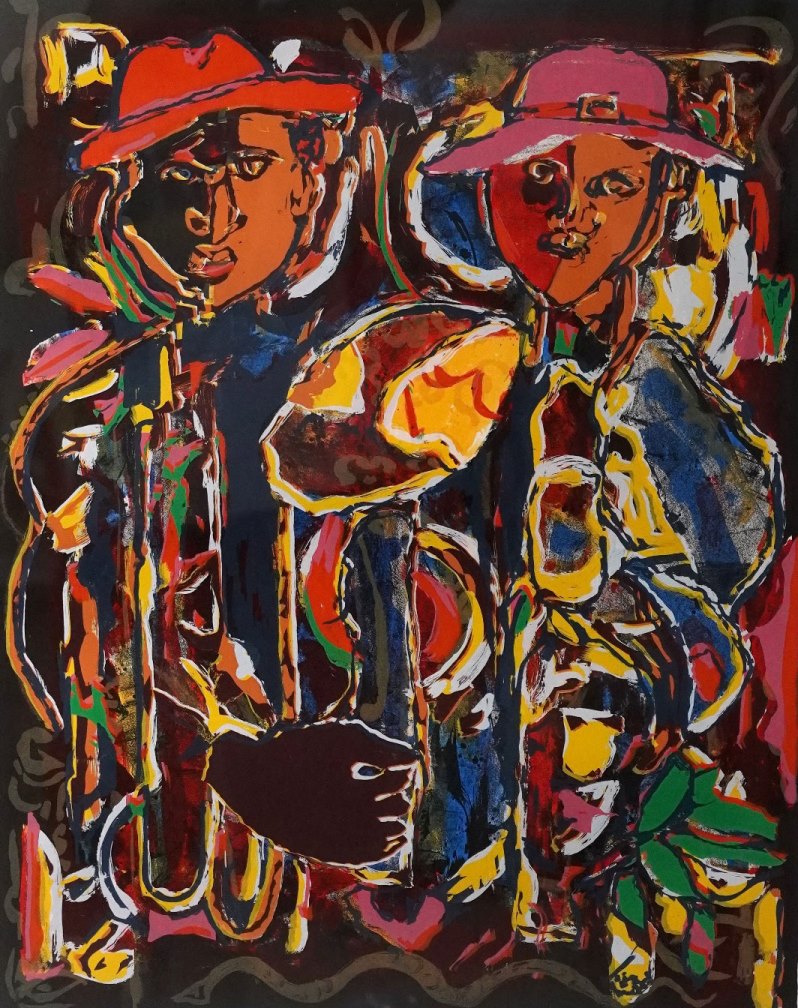Clementine Hunter, the most famous woman artist from Louisiana, was defined by her love of community and her need for self-expression. The unlikely trajectory of her career, from humble servant to renowned artist, is a prime example of the prototypical American Dream, albeit deferred.
Her paintings remind me of the traditional Naive art style from the Caribbean, and also feature hallmarks of American abstraction. I look at her themes and figurative drawing style, and I see similar echoes in Jacob Lawrence’s work; I note her gender and age, which is comparable to Grandma Moses’. However, her personal association with the subjects that she painted over and over– her church, her workplace, and everyday events– set her far apart from either one. In the context of the National Museum of African American History and Culture (NMAAHC), these works also become artifacts that show the world of the mid 20th century through the eyes of a self-taught, older, Black woman– the exact sort of person that has habitually been overlooked in our country’s history. Her testimony of that particular time is vital to people’s understanding of it today.
Overall, the innocence of Hunter’s artwork counters the harsh conditions she endured in her lifetime. And that story of perseverance, in all of its rawness, is also my story. It is one that I’ve heard within my own family and about other Black families; an ongoing tale of people, places, and things that my elders have entrusted me to remember. For Hunter, the hardships that she faced on Melrose Plantation were not shameful but were treasured memories that she had of her youth. Through her art, she has paid reverence to the people and places that gave her life meaning.
The following conversation took place on October 9th, 2018, with Dr. Tuliza Fleming, NMAAHC’s chief curator of fine art, and Ms. Jia Sun Tsang, conservator, about Clementine Hunter’s life and paintings. This transcript has been edited for length and clarity.
Dr. Fleming (DF): Tell me what you know about Clementine Hunter.
Lyric Prince (LP): I’ve talked to a collector of her work once and researched a bit about her online. That’s as far as I got.
DF: So, she’s from Natchitoches, Louisiana. She’s Creole, and this is an exhibition detailing her life on the plantation. Hunter was born in 1887. Her parents were sharecroppers before, but they were offered a salary at Melrose Plantation. The family moved there in 1902, [when] she was 15 years old.
She started art when she was in her 50s, in the 1930s. She didn’t really go to school—she only had one year of formal education. She never learned how to read and write. Hunter worked as a laborer, picking cotton and pecans, in her youth. She [would talk about] how much she enjoyed picking cotton. [We both share a confused glance, and laugh.] I think that it was probably a meditative thing for her, that you do this sort of labor and you think about things.
LP: Its repetition can be soothing.

Above: Picking Cotton by Clementine Hunter.
DF: When she got too old to work in the fields, she began to work in the ‘big house’ on the plantation as a domestic. The owner of the plantation, Cammie Henry, was a real supporter of the arts, and she would often have writers and artists come in, like a residency. So the artists would stay there, and this is when [historians] first believe that [Hunter] encountered fine art painting. But the story is conjecture in some ways… we don’t know if she met the artists, or talked to them, but she knew the painters living in the homes…

Above: Window Shade by Clementine Hunter.
LP: She learned through osmosis, I guess.
DF: Yes! So, she started painting, and a few years later, this writer came to stay at the plantation—Francois Mignon. He really saw Hunter’s talent, promoted it, started giving her art materials. He created this whole mythology around the plantation [laughs a little] and, you know, his name wasn’t really Francois Mignon. It was Frank Mineah.
LP: Was he was trying to co-opt the Creole culture?
DF: He said he was French, born in Paris. But he was born in NY! I think he was a compulsive liar! I don’t know why he would make that up, to go down south and do that.
LP: Because it worked better for him, probably.
DF: He also became the plantation’s ‘historian’ and archivist, because the Henry family loved him. Cammie later found out that he wasn’t who he said he was. They were heartbroken…
LP: I see.
DF: So, [Mignon] created this mythology around her [Hunter,] and he was really the one who made her famous. For example, this painting of Africa House—he named that house. It was called, prior to that, ‘Mushroom House’ and ‘Casa Verde.’ He decided it was Africa House, primarily because it’s a good story.
 Above: Untitled-Africa House by Clementine Hunter.
Above: Untitled-Africa House by Clementine Hunter.
LP: Right.
DF: He also thought it had Congolese architectural elements, but it’s really French and French Creole. It looks a lot like a farmhouse in France. And he named this other house ‘Yucca house.’ And it was a very simple mythology because Louis Metoyer, the first owner of the plantation, was a mixed-race Creole, and [his] mother was African. Mignon really started promoting this idea of the Melrose Plantation having this history of ‘Africaness,’ which… cannot be right!
[Both of us laugh. We move over to a church image.]
DF: So, it was really interesting on how this plantation got started. The church, which she painted over and over again…[was called] St Augustine Church, the first church in Louisiana founded by a mixed-race family, the Metoyers. I think that they lost [the plantation] in the second generation, and the Hertzog family brought it, and then the Henry family.
LP: So, could you tell me a bit about the perspective, and some of her methods? I’m looking at these pictures, and clearly, she’s not trained in traditional artistic ideas—perspective, scale, etc. that artists typically are taught.
DF: Right, she was self-taught.
LP: So, could you talk about how she would plot different elements of the pictures? What sort of things would she emphasize? For what reasons?

Above: Baptizing with Lady in Oragnge Dress by Clementine Hunter.
DF: Yes–look at this piece right here [points to a large picture in the middle of the wall, of Melrose Plantation]. Often self-taught artists – and she’s not the only one; even if you look at Byzantine artists—they have these layers that connote depth. So, if you look at the this, clearly the church is background and you can read it like that, but she just doesn’t have that perspective. But, it still works.
LP: It does. Also, I know that with different elements of religious art, size denotes importance.
DF: Yes! So, for example, her women were always bigger than the men (She sort of respected women more than she respected men.) If you see in this painting, all the women are working, and you see all of these small men drinking in the shade! I don’t know if it’s alcohol or not…

Above: Washday by Clementine Hunter.
LP: Probably! [we both giggle]. So, ]with her role as domestic, how did that shape what she saw in daily life and what she painted?
DF: She painted mostly what she saw. She didn’t go ‘out’ much or anything, she was pretty much a homebody. This is her community and the community of the Melrose Plantation and the surrounding communities. And so, a lot of what she painted was from memory—she was no longer working in the fields when she began to start painting. They’re just things that she saw around her, that was the important part. So there are things that come in over and over again: religion, work, church, leisure activities, flowers that she loved… We only picked three themes in her work [for the exhibit], but there are other things that she also painted. And… they tend to be the same. She painted over and over again between five and 10 thousand paintings.
LP: Wow. Five to ten thousand?
DF: She was a very compulsive artist. You see some artists like that.

Above: A collection of Clementine Hunter’s work.
LP: Finally, with her color palette- could you tell me a bit about how [and] why she chose these colors? Or were they just there, by happenstance?
DF: People gave her … materials [and] would bring paints to her. I think you see the repetition of blues and greens—but also, she’s doing landscapes! With the sky, most people painted blue. I think that probably, this sort of salmon color is the most interesting, and I’m not sure why she chose to sort of differentiate the landscape like that. I can’t imagine unless this was some sort of dirt or red clay, but I don’t believe that was the case. It might have just been a color that she wanted to use.
LP: It’s also in the sky. It has a sort of cooling effect, so you can see what’s closer in contrast.
DF: And maybe if [the ground] were all green, it would be too dark; you’re correct.
LP: Green is pushed very much to the foreground because of that salmon color receding everything else. It’s wonderful that she could just pick that up and use that effect in a very sophisticated way.
DF: Yes.
LP: Ms. Tsang, may I ask you a question about conserving these paints? What sort of paints did she use?
Jia Sun Tsang (JST): They were oil-based.
LP: So, what did you have to do to make this ‘show-ready?’
JST: We worked on [the exhibition] for a whole year. Her paintings came to our studios (I’m located in Suitland, MD) and we are in a unit that is interdisciplinary with scientists and conservators. We studied the technique, the materials before we really started treatment. So, most of her paints are oil based, and some are of quite high quality, because contrary to people’s beliefs, she was using and was given good materials. But the support is a little challenging. She painted on any found materials. So, cardboard, wood, and as you know, they are not archival [quality] materials, and they degrade [over time.] With some of her oil paintings on cardboard, preservation can be a challenge. Anything [we use] to clean, we made sure that it was water-solvent sensitive and would not go through the paint layer into the support.
LP: And thinking about that—there’s all of this amazing material to work with, but what to put it on? Canvas is so expensive. That’s probably how a lot of artwork gets lost because artists aren’t able to store it correctly or have somewhere to help preserve it.
JST: What she would do differently than the traditional painting technique that was [hardest] was to not lay [gesso] on the [material.] You know, it works to seal [the support,] so that the paint won’t go through. Sometimes, if you look carefully, you can see [the support] coming through, because she didn’t use preparatory materials… to cover that.
Insert Africa House detail here.
LP: Looking at it now, the choice of frame is very important. You have to have it match the look and feel of the art piece itself.
JST: I’m glad that you mentioned that. You can see with this one, with the [support] materials, how uneven the edges [of it] are. We just wanted to make sure to show that because that’s her authentic self and artwork.
LP: I think that’s a good choice.
Clementine Hunter: Life on Melrose Plantation is currently on view in the Rhimes Family Foundation Visual Arts Gallery at NMAAHC.









